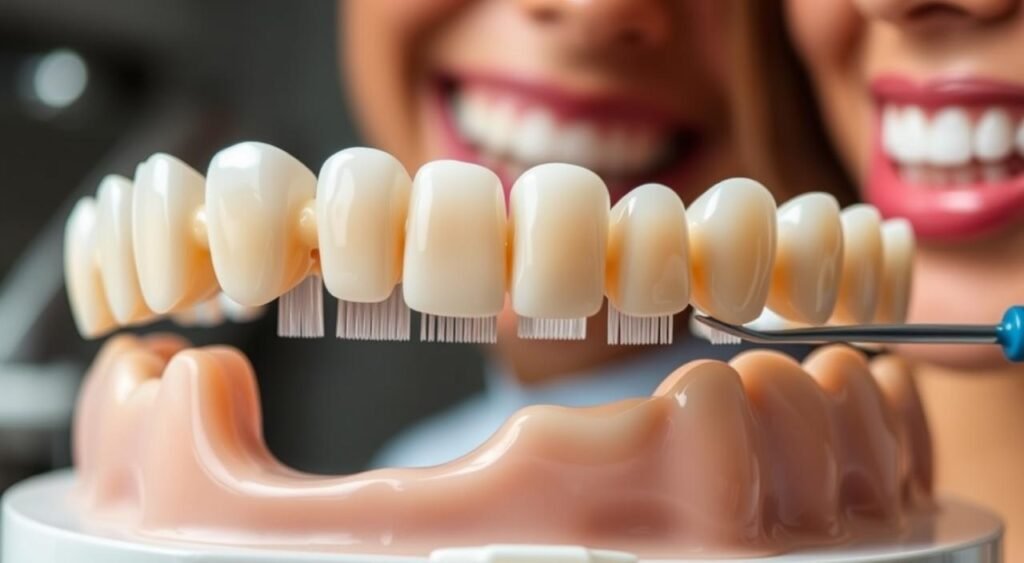Have you thought about how missing teeth might affect your confidence and oral health? Dental bridges are a great choice for replacing teeth. They not only improve how your teeth look but also work better. If you’re dealing with tooth loss, learning about bridgework teeth and dental bridges can help you feel more confident and improve your life.
At Ingenious Dentistry, in Texas Medical Center’s Scurlock Tower, we focus on helping you find the right dental bridge. This article will cover the basics of dental bridges, their types, and what to expect during the process. Let’s explore how dental bridges can help you get your smile back!
Understanding Dental Bridges
A dental bridge is a great solution for people with missing teeth. It makes your smile look better and helps keep your mouth healthy. So, what is a dental bridge? It’s an artificial tooth, called a pontic, that fills gaps from missing teeth. The bridge has three main parts: the healthy teeth next to the gap, called abutments, and the pontic. This setup helps you chew and smile better.
What Is a Dental Bridge?
Dental bridges can make your life better by letting you chew and speak right. They keep your face looking good and stop other teeth from moving. These bridges can last 5 to 15 years, based on the type and how well you take care of them.
How Does a Dental Bridge Work?
To get a dental bridge, your teeth need to be prepared as abutments. This lets the crowns hold the bridge in place. Then, a temporary bridge is made to protect your teeth while the final one is being crafted. Once it’s in, you can chew like normal. You might feel some discomfort at first, but it goes away soon. Remember, taking good care of your bridge and seeing your dentist regularly can make it last longer.
Benefits of Dental Bridges
- Improved chewing ability.
- Restoration of aesthetics, enhancing your smile.
- Reduced strain on remaining teeth, promoting overall oral health.
- Prevention of gum disease by keeping teeth aligned.
Dental bridges offer more than just function. They help spread out the force of your bite, keeping your jaw healthy. When thinking about replacing teeth, dental bridges are a strong choice.

Bridgework Teeth: A Solution for Missing Teeth
Bridgework teeth are a great way to fix gaps from missing teeth. They make your smile look better and work better, letting you smile freely again.
How Dental Bridges Restore Your Smile
Dental bridges fill in gaps from missing teeth, making your smile look whole and natural. They are made with care and placed with precision. This keeps your face looking right and lets you eat and speak normally.
Regular bridges can replace more than one tooth, filling gaps for up to six missing teeth. This gives you more options for fixing your smile.
The Role of Pontics and Abutments
Pontics are key in bridgework, acting as the new teeth that fit perfectly. Abutments are either natural teeth or implants that hold the pontics in place. Together, they stop your other teeth from moving, keeping your mouth healthy.
Choosing the right bridge depends on your specific needs. A detailed check-up with your dentist is important to find the best solution for you.
Types of Dental Bridges Available
When looking into tooth replacement, knowing the different dental bridges is key. Each type has its own purpose and fits different dental needs. The main types include traditional, cantilever, Maryland, and implant-supported bridges.
Traditional Bridges
Traditional bridges are the most common. They need healthy teeth on both sides of the gap. Made from porcelain fused to metal or ceramics, they are strong. The teeth on both sides hold the bridge in place, making them a dependable choice.
Cantilever Bridges
Cantilever bridges work when you have only one healthy tooth next to the gap. They use off-axis forces from one side to hold the pontic. These bridges are less common but often used in the front of the mouth.
Maryland Bridges
Maryland bridges focus on looks, perfect for replacing front teeth. They have a metal frame with porcelain teeth that attach to the nearby teeth without crowns. This method changes healthy teeth little, making it a budget-friendly option.
Implant-Supported Bridges
Implant-supported bridges use dental implants for support, not just the teeth next to the gap. They’re great for replacing many teeth and are known for being comfortable and lasting long. Getting implants requires surgery but is a solid fix for tooth loss.
Candidates for Dental Bridgework
Choosing the right candidates for dental bridgework means checking your oral health closely. It’s key to look at your dental health before deciding on dental bridges. The success of the treatment depends on your gums and teeth health, and how well you keep your mouth clean.

Assessing Your Dental Health
Your dentist will check if you’re a good fit for dental bridges. They’ll look at several things:
- Health of gums: Gum disease can make the process harder.
- Condition of adjacent teeth: Healthy teeth are important for the bridge’s stability.
- Bone density: You need enough bone to hold the bridge in place.
Keeping your mouth clean is crucial for your dental health. People thinking about dental bridgework should brush, floss, and visit the dentist regularly.
Factors to Consider Before Getting a Dental Bridge
There are many things to think about before getting dental bridges:
- Overall health: Some health issues or medicines might affect your eligibility.
- Type of dental bridge: You can choose from traditional, cantilever, Maryland, or implant-supported bridges, depending on what you need.
- Patient preferences: Your looks and what you want can guide your choice.
- Longevity of the bridge: Bridges usually last 5 to 15 years, so plan accordingly.
Knowing how to check your dental health and what to consider before getting a dental bridge can really help. Keeping your mouth healthy is key to making dental bridgework work well.
| Factor | Importance |
|---|---|
| Healthy Gums | Critical for support and healing |
| Strong Abutment Teeth | Essential for the stability of the bridge |
| Bone Density | Necessary for anchoring the bridge |
| Patient’s Overall Health | Influences treatment options and outcomes |
| Oral Hygiene Practices | Vital for longevity and maintenance |
The Bridgework Procedure: What to Expect
The bridgework procedure is a step-by-step process to fix your smile. Knowing what happens can make you feel more at ease. It usually takes two visits, each important for great results.
Initial Consultation and Tooth Preparation
Your first step is an initial consultation and tooth preparation. The dentist will check your teeth and might take X-rays. This helps them see how a bridge can help you.
Then, the dentist will prepare the teeth for the bridge by removing a bit of enamel. This makes a strong base for the bridge. Next, they take impressions for a custom bridge that looks like your real teeth. Sometimes, a temporary bridge is put in to protect your teeth while the final one is made.
Local anesthetic is used to keep you comfortable during this.
Bridge Placement and Fitting
The second visit is for placing and fitting the bridge. The dentist puts in the permanent bridge, making sure it fits right and feels good. You might feel like the bridge is new at first, but this feeling goes away soon.
You’ll get advice on how to take care of your bridge, like brushing and flossing. Going to your dentist regularly can make your bridge last more than ten years. If you feel pain after the procedure, tell your dentist right away.
Cost of Dental Bridges and Insurance Considerations
Understanding the cost of dental bridges is key to making a smart choice. The price changes based on the bridge type, materials, and where you live.
Average Costs of Dental Bridges
The cost of dental bridges is usually between $1,500 and $5,000. A bridge for one missing tooth costs about $3,965 on average. Traditional bridges are priced between $2,000 and $5,000, and Maryland bridges are in the $1,500 to $2,500 range.
The total cost can go up a lot if you need more teeth replaced or extra procedures like tooth extractions or X-rays.
Insurance Coverage for Dental Bridges
How much your insurance covers can really affect what you pay out-of-pocket. Most plans, like Delta Dental, cover 50% to 80% of the cost after you meet your deductible. This is for dentists in your network. Costs can be higher if you go to an out-of-network dentist.
Over 33% of people don’t have dental insurance. This can make the cost a big problem. It’s a good idea to talk to your dental provider to see what’s covered and what you’ll pay.
Dental Bridge Maintenance and Care
Keeping your dental bridge in top shape is key for its look and function. Good dental bridge care helps it last longer and avoids problems. This part talks about important daily care tips and why regular dental check-ups are vital.
Daily Care Tips for Your Dental Bridge
Looking after your dental bridge means sticking to a good daily routine. You don’t need to spend more time on it, but being consistent is important. Here are some tips to help you:
- Brush your teeth, including the bridge, twice a day with fluoride toothpaste.
- Floss every day to clean between your bridge and natural teeth. Use floss threaders or super floss for better access.
- Use interdental brushes or water picks to clean around the bridge and remove food bits.
- Rinse with an antiseptic mouthwash to kill bacteria and keep your gums healthy.
- Avoid eating hard or chewy foods that could damage your bridge.
Importance of Regular Dental Check-ups
Going to the dentist regularly is crucial for your dental bridge’s health. You should see your dentist at least twice a year. These visits help with:
- Finding problems early with your bridge.
- Professional cleaning to remove dental calculus and prevent gum disease.
- Checking the bridge’s fit to avoid damage to your teeth.
- Reviewing your oral hygiene routine to make sure you’re caring for your bridge right.
Staying committed to dental bridge care and regular dental check-ups keeps your smile looking great for years.
Conclusion
Dental bridges are a great way to fix gaps in your teeth, making you smile with confidence. You can choose from traditional, cantilever, and Maryland bridges, depending on what you need. Each type helps improve how your teeth look, work, and even how you speak.
Getting dental bridges involves several visits to make sure they fit right and feel good. Some people use a temporary bridge while they wait for the final one. With good care, these bridges can last up to 10 years or more, boosting your oral health and looks.
It’s important to keep up with regular dentist visits to make sure your bridges last. By taking good care of your teeth and following your dentist’s advice, you can keep your bridges working well for many years. This will help you feel confident in your smile for a long time.
FAQ
What is the difference between a dental bridge and a dental implant?
A dental bridge is an artificial tooth held by nearby healthy teeth or implants. It fills gaps left by missing teeth. A dental implant is a metal post placed in the jawbone. It acts as a base for a new tooth. Both options improve looks and function. The choice depends on your situation and what you prefer.
How long does a dental bridge last?
Dental bridges can last 5 to 15 years or more with good care. Regular dental check-ups and proper oral hygiene are key to their long life.
Are dental bridges uncomfortable to wear?
At first, you might feel some discomfort as your mouth gets used to the bridge. But most people find them comfortable and natural once they’re fitted right by their dentist.
How much do dental bridges generally cost?
Dental bridges can cost between $2,000 to $5,000 or more. This depends on the bridge type, materials, and where you live. It’s a good idea to talk to your dentist and insurance to know the costs for you.
What types of dental bridges are available?
There are different dental bridges like traditional, cantilever, Maryland, and implant-supported bridges. Each type is for different needs, based on where teeth are missing and the health of nearby teeth.
How should I care for my dental bridge?
Take care of your dental bridge by brushing twice a day and flossing often, especially around the bridge. Using special tools to clean hard-to-reach areas helps keep your mouth healthy and stops plaque.
Who are ideal candidates for dental bridges?
People with healthy gums and enough bone support are good candidates for dental bridges. Your dentist will check your oral health and consider your conditions before suggesting a bridge.
What is the bridgework procedure like?
The bridgework process usually takes two visits. First, your dentist prepares the teeth for the bridge and takes impressions. Then, at the second visit, they fit and secure the bridge, making sure it’s comfy and works well.








